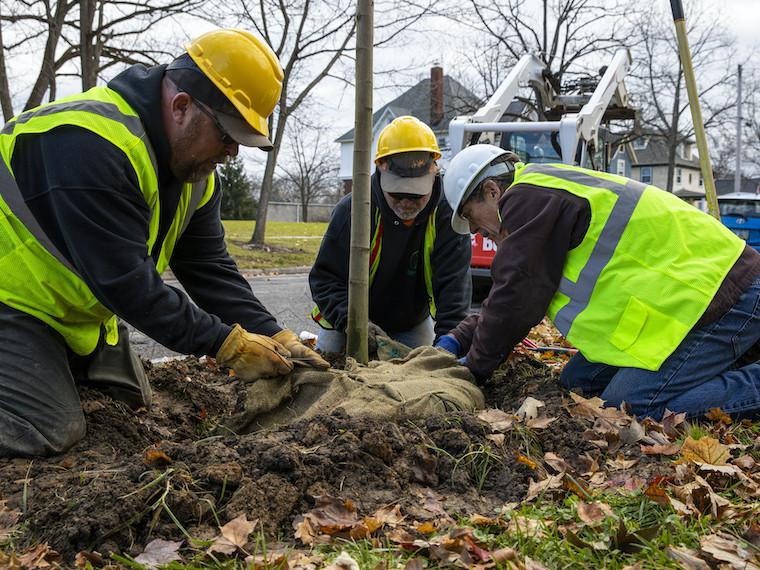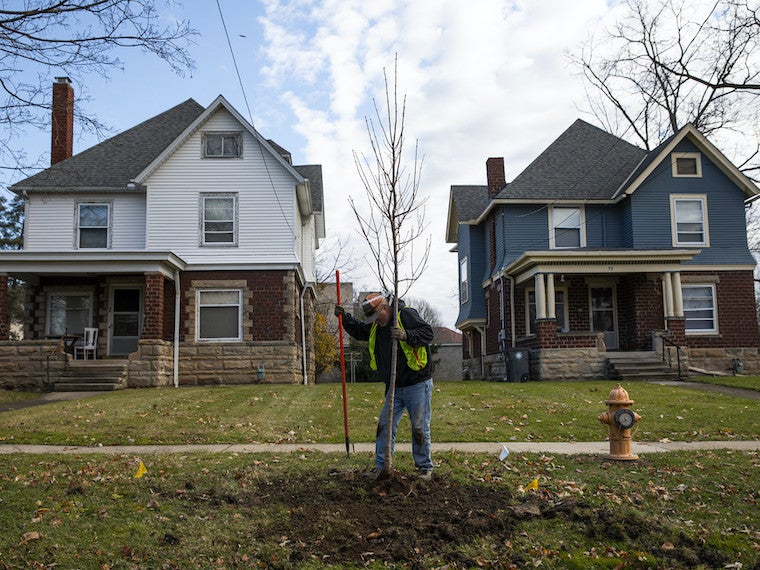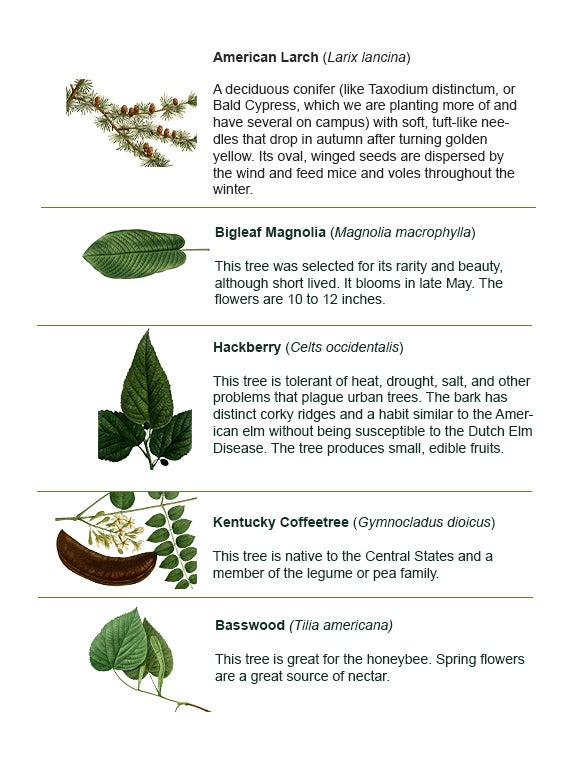Phase One of SIP Project Ends with a Campus and City Tree Planting
December 9, 2021
Office of Communications

Workers plant one of more than 100 trees to be replanted on campus and in the city of Oberlin this month.
Photo credit: Rebecca Devereaux
A large flatbed truck parked on North Professor Street late last month brought the first of 126 trees to be planted in Oberlin this semester.
After a worker guided the burlap covered bundles into the bucket of a skid steer, the young trees were eased onto a patch of lawn on the back corner of King Building. The next day, planting began.
The arrival of trees marked the end of the first of five phases involved in the Sustainable Infrastructure Program (SIP), a major step toward achieving a carbon-neutral campus by 2025. The goal of SIP is to upgrade the century-old heating infrastructure serving the campus to a hot water system. This work will enable a large-scale geothermal system, add cooling to buildings, and implement other structural improvements that will increase student and faculty comfort year round.

This modernization to Oberlin’s sustainable campus infrastructure will impact, and ultimately improve the energy system, buildings, and this important third piece of the physical campus make-up: the campus landscape. The construction sites that students, faculty, and staff navigated through the summer session have been restored and sidewalks and parking lots have been reformed.
During the next few weeks, trees that were removed for the installation of underground distribution pipes will be replanted on campus and on city curb lawns. Minimally, every tree that was removed will be replaced; and in some cases, will be replaced with two trees. By the end of this first phase reinstall, 65 trees will be planted on campus and 61 in the city.
 A wide range of considerations—such as the city’s tree replacement guide, Ohio native species, interplay of diverse species, structural integrity of a species, and aesthetics—went into the criteria used for replacement tree selection and planting locations. The goal is to not only have a robust diversity of species that will continue Oberlin’s long tradition of a beautiful and unique campus landscape, but one that is beneficial to minimize potential future impacts of pests, disease, and climate change that can harm the tree canopy.
A wide range of considerations—such as the city’s tree replacement guide, Ohio native species, interplay of diverse species, structural integrity of a species, and aesthetics—went into the criteria used for replacement tree selection and planting locations. The goal is to not only have a robust diversity of species that will continue Oberlin’s long tradition of a beautiful and unique campus landscape, but one that is beneficial to minimize potential future impacts of pests, disease, and climate change that can harm the tree canopy.
“Our goal is to make choices today that will stand the test of time,” says Grounds Service Manager Becky Bode who is spearheading the reinstall alongside Arborist Al Shauck. “We selected trees that will thrive on campus and enhance the [landscape] experience for those attending Oberlin 100 years from now.”
The tree replacement phase in SIP is also an opportunity to introduce woody perennial plants that will complement the college’s landscape and buildings, while working to avoid the complex network of underground utilities.
Included in the types of trees being planted is the American larch, a specimen, according to Bode, that can now only be found in Oberlin’s nearby Arboretum. Bigleaf magnolia was selected for its rarity and beauty. Other trees being planted also carry an added historical reference, such as the hackberry tree, which was once used for flooring and barrel hoops in pioneer days. (Read the sidebar for additional information on some of the trees being planted.)
Trees for the project were reared in Split Rail Nursery in Circleville, Ohio; Klyn Nursery in Perry, Ohio; and Davis Tree Farm in Valley City, Ohio.
“The tree replacement plantings for the first phase of work mark a milestone on our Oberlin College journey to meet our ambitious carbon neutrality commitment,” says Meghan Riesterer, assistant vice president of campus energy and sustainability. “The first of four phases of the Sustainable Infrastructure Program wraps up in December with this final piece of getting our campus back to its beautiful state with the trees planted to complete the restoration of construction sites.”
Removal and replacement of trees will continue this summer with phase two of SIP.
You may also like…
Josh Nolan Named Vice President, General Counsel, and Secretary at Oberlin
Distinguished attorney brings extensive experience in higher education law.
Learning by Teaching: Oberlin Students Share Global Music with Young Learners
College and Conservatory students in PACE 103 prepare local children for an immersive community concert at Oberlin.
Nuiko Wadden ’02 Joins Oberlin Conservatory Faculty as Assistant Professor of Harp
The versatile musician brings extensive opera, orchestral, and contemporary music experience to her role


